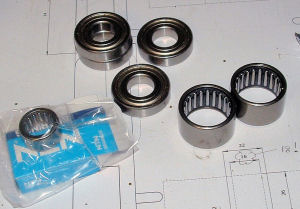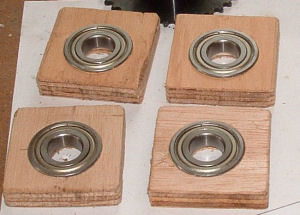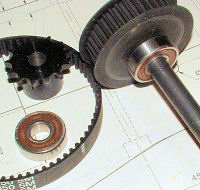 Over a fair
number of DIY vehicle builds I've moved towards using
needle roller bearings almost
exclusively. I prefer
these because of their low cost and compact size
relative to the shaft sizes they run on - in particular
their small outside diameters are very helpful and the
fact that several standard needle roller bearing sizes
have outside diameters that match available standard
wood and metal dill bit sizes. This matters - they have
to be housed in snug fitting housings and these are
straightforward to drill if the hole size matches the
drill bits you have. Aside from size and cost needle
rollers used without the vendors inner races will fit
easily on standard sizes of bright steel shafting
without the need for press or other "forced" fits. This
is suitable for our types of DIY leisure vehicles which
will not see years of heavy duty. For industrial use
they are intended to be pressed into metal housings which
causes the roller PCD to compress slightly and so result in
a close fit on the shaft. With wooden housings, as used in
many of our vehicles, this isn't possible and the shafts run
slightly looser than strictly speaking intended - but still
quite happily for the light duties seen by our designs.
Over a fair
number of DIY vehicle builds I've moved towards using
needle roller bearings almost
exclusively. I prefer
these because of their low cost and compact size
relative to the shaft sizes they run on - in particular
their small outside diameters are very helpful and the
fact that several standard needle roller bearing sizes
have outside diameters that match available standard
wood and metal dill bit sizes. This matters - they have
to be housed in snug fitting housings and these are
straightforward to drill if the hole size matches the
drill bits you have. Aside from size and cost needle
rollers used without the vendors inner races will fit
easily on standard sizes of bright steel shafting
without the need for press or other "forced" fits. This
is suitable for our types of DIY leisure vehicles which
will not see years of heavy duty. For industrial use
they are intended to be pressed into metal housings which
causes the roller PCD to compress slightly and so result in
a close fit on the shaft. With wooden housings, as used in
many of our vehicles, this isn't possible and the shafts run
slightly looser than strictly speaking intended - but still
quite happily for the light duties seen by our designs.
There are one or
two disadvantages though. The rollers run directly on
the shaft and if the shaft material is soft it will
 compress and mark under the contact stresses from the
loaded rollers - if possible use hardened shafts. The shaft also has
to have a good (smooth) surface finish to make life easy
for the tiny needle rollers. These types of bearings are
not designed to carry any axial loads, so sideways loads
from wheels etc have to be supported by other means,
usually lubricated plain washers between the wheels and
the bearing housing will do the job. If the sideways
forces are large and friction arising from reacting them
has to be avoided then other types of bearings need to
be considered. A further downside of simple needle
roller bearings is the lack of protection for the
rollers from ingress of dirt or water. The commonly
available low cost versions I've come across do not have
seals, however a generous dollop of grease will help keep
moisture out - if they are to be subjected to
wet conditions it may be better to use a sealed bearing
type. You also need to make sure they remain lubricated.
Their main advantages are low size and low cost!
compress and mark under the contact stresses from the
loaded rollers - if possible use hardened shafts. The shaft also has
to have a good (smooth) surface finish to make life easy
for the tiny needle rollers. These types of bearings are
not designed to carry any axial loads, so sideways loads
from wheels etc have to be supported by other means,
usually lubricated plain washers between the wheels and
the bearing housing will do the job. If the sideways
forces are large and friction arising from reacting them
has to be avoided then other types of bearings need to
be considered. A further downside of simple needle
roller bearings is the lack of protection for the
rollers from ingress of dirt or water. The commonly
available low cost versions I've come across do not have
seals, however a generous dollop of grease will help keep
moisture out - if they are to be subjected to
wet conditions it may be better to use a sealed bearing
type. You also need to make sure they remain lubricated.
Their main advantages are low size and low cost!
The least expensive type of rolling element bearing
which also has some axial load capacity and can be
sealed (to keep lubricant in and
 water and dirt out) is
the deep groove ball bearing. These are commonly
available and are supplied (as with most other types of
rolling element bearing) as a unit with both inner and
outer races, balls and internal cage (interestingly the
cyclists call them "cartridge" bearings, although most of
the engineering world simply call them bearings). They
are not as compact as needle rollers but do have good
load bearing capacity and do not run directly on the
shaft - so shaft hardness and surface finish is less
important (at least as far as the bearing is concerned).
For the same shaft size their outside diameter is much
larger than the matching needle roller bearing's so
drilling housings can be more problematical. Deep groove
ball bearings can be bought either with integral rubber
seals or with metal shields. They are more expensive
than needle rollers but will react axial loads.
water and dirt out) is
the deep groove ball bearing. These are commonly
available and are supplied (as with most other types of
rolling element bearing) as a unit with both inner and
outer races, balls and internal cage (interestingly the
cyclists call them "cartridge" bearings, although most of
the engineering world simply call them bearings). They
are not as compact as needle rollers but do have good
load bearing capacity and do not run directly on the
shaft - so shaft hardness and surface finish is less
important (at least as far as the bearing is concerned).
For the same shaft size their outside diameter is much
larger than the matching needle roller bearing's so
drilling housings can be more problematical. Deep groove
ball bearings can be bought either with integral rubber
seals or with metal shields. They are more expensive
than needle rollers but will react axial loads.
 For some low speed non friction critical jobs plain
(sliding) bearings might be considered. You can get
these in both bronze and plastic materials. Bronze types
can be bought impregnated with lubricating oil (oilite
bearings), several types of plastic bearings can be used
"dry" i.e. without external lubrication and can be used as
steering column bearings etc. You might be surprised to
find though that some plain bearings actually are more
expensive than their equivalent sized needle roller
bearings.
For some low speed non friction critical jobs plain
(sliding) bearings might be considered. You can get
these in both bronze and plastic materials. Bronze types
can be bought impregnated with lubricating oil (oilite
bearings), several types of plastic bearings can be used
"dry" i.e. without external lubrication and can be used as
steering column bearings etc. You might be surprised to
find though that some plain bearings actually are more
expensive than their equivalent sized needle roller
bearings.
There are other types of rolling element bearings
available (e.g. tapered, spherical, cylindrical etc), but
most cost more than the above types and aren't really
warranted for light duty DIY applications where cost is
such an important issue. Standard size bearings are now
an engineering commodity and there are several bearing
manufacturers all with excellent and informative web
sites where you can read-up if you want more technical
detail. Try SKF Bearings here or
Timken Bearings
here.